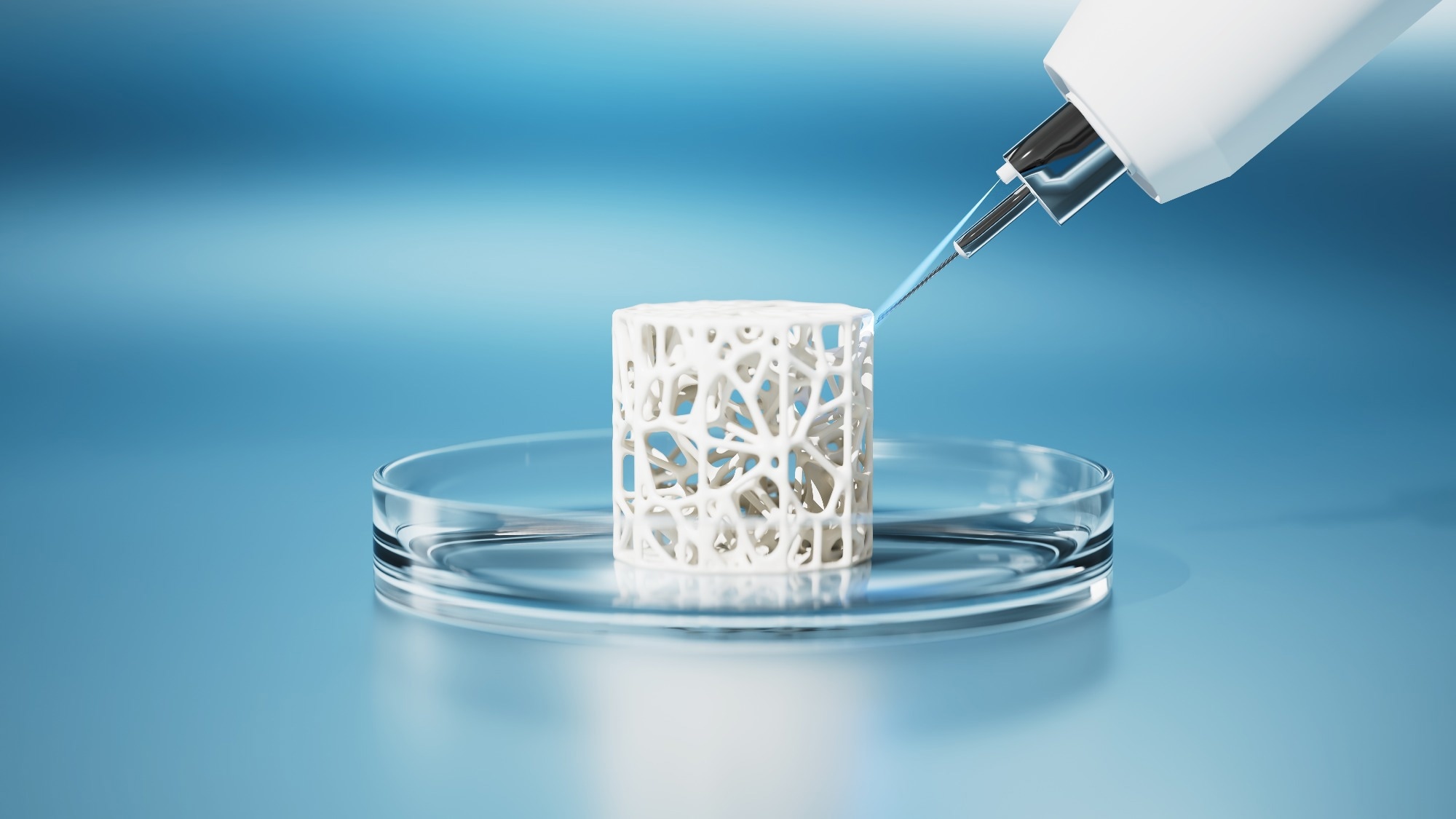A recent study published in the journal Advanced Healthcare Materials introduced photoclickable collagen-based bioresins for deep vat printing (DVP), enabling rapid, high-resolution fabrication of complex multicellular tissue constructs. By combining thiol-ene chemistry with tomographic and filamented light (FLight) printing, researchers aimed to enhance print resolution, mechanical strength, and biomimicry.

Image Credit: GarryKillian/Shutterstock.com
The findings highlight the significant role of optical and material design in advancing biologically relevant tissue engineering applications in regenerative medicine.
Innovations in Bioprinting Techniques
Additive manufacturing, especially three-dimensional (3D) bioprinting, has significantly advanced tissue engineering by enabling the fabrication of complex, patient-specific constructs. Among emerging techniques, DVP stands out for producing high-resolution 3D structures without discrete layering. It includes optical techniques like tomographic Printing, which uses dynamic projection of radon-transformed images into a rotating vial of photoresin for volumetric crosslinking, and FLight printing, which utilizes speckled laser light to create self-focused filaments that guide cellular alignment, mainly for muscle and nerve tissues.
These methods require advanced photocurable materials. Traditional acrylate and methacrylate-based polymers face challenges such as oxygen inhibition and network inconsistency. In contrast, thiol-ene step-growth photoclick chemistry provides uniform crosslinking, fast kinetics, and compatibility with biological systems.
Collagen, the most abundant protein in the extracellular matrix, is ideal for DVP bioresins due to its bioactivity and relevance. However, it has posed challenges in print fidelity and handling. This study introduced photoclickable collagen-based resins optimized for DVP, enabling high-resolution, mechanically robust, and biomimetic tissue constructs.
Development and Characterization of Bioresins
Researchers functionalized type I collagen with norbornene (ColNB) and crosslinked it with either 4-arm polyethylene glycol thiol (4PEGSH) or thiolated gelatin (GelSH). This technique allows rapid, oxygen-insensitive thiol-ene photopolymerization under 405 nm light.
They adjusted the degree of norbornene functionalization (DoF) to low (0.481 mmol mg-1), medium (1.323 mmol mg-1), and high (2.25 mmol mg-1) levels to modulate crosslinking kinetics and mechanical properties. Techniques such as proton nuclear magnetic resonance (1H NMR) confirmed successful functionalization and preservation of collagen’s triple-helical structure. Rheological analyses indicated that higher DoF levels improved resin stability by suppressing temperature-induced gelation. Iodixanol was introduced as a refractive index (RI) matching agent, enhancing print resolution while inhibiting collagen fibrillogenesis.
Low DoF formulations retained some physical gelation at neutral potential of hydrogen ion (pH), whereas higher DoF resins allowed easier handling. Both resin types achieved similar mechanical stiffness (about 1 kPa storage modulus post-crosslinking). Tomographic printing utilized the Tomolite system to create complex 3D structures with perfusable channels, achieving resolutions between 220-400 µm, while FLight printing generated microfilaments (1.8-15 µm diameter; 10-20 µm lateral resolution) to promote cellular alignment.
Performance Evaluation of Collagen-Based Constructs
FLight printing achieved superior feature resolution compared to tomographic printing, due to unidirectional light projection that minimized off-target crosslinking. While tomographic printing excelled at fabricating complex geometries, FLight printing produced aligned microfilaments that served as cues for anisotropic cellular organization.
Both methods supported high cell viability (>90%) in C2C12 myoblast and 3T3 fibroblast co-cultures but resulted in distinct biological outcomes. Tomographically printed muscle-connective tissue interfaces showed cell proliferation but lacked aligned myotubes. In contrast, FLight-printed constructs promoted myotube alignment and organized sarcomeres with physiologically relevant spacing (~2.68 µm). Myotube diameters were significantly larger in FLight prints (~28.4 µm vs. ~16.5 µm), closely resembling native muscle architecture.
Similarly, immunofluorescence confirmed enhanced expression of myosin heavy chain and sarcomeric alpha-actinin in FLight constructs, along with increased integrin β1 levels in collagen-based ColNB-GelSH hydrogels relative to gelatin-based controls. Iodixanol improved RI matching (~1.37), reduced light scattering, and enhanced print fidelity.
Implications for Biomedical Engineering
This research has significant potential for tissue engineering by enabling the creation of collagen-based constructs that closely mimic the extracellular matrix. The photoclickable nature of the resins allows for precise control over crosslinking, facilitating the fabrication of complex tissue architectures that support cell proliferation and differentiation.
The tomographic method enables rapid fabrication of complex tissues, while FLight printing’s microfilament-guided anisotropy is ideal for generating aligned cellular structures. By preserving collagen’s native bioactivity and strength, the resins offer a more physiologically relevant alternative to gelatin-based systems, enhancing cell attachment and function.
Conclusion and Future Directions
In summary, the integration of photoclickable collagen-based bioresins with DVP represents a transformative advancement in tissue engineering. These resins combine mechanical tunability, biochemical relevance, and optical compatibility, enabling high-resolution fabrication of functional tissues. Future work should explore thiolated collagen crosslinkers for fully collagen-based systems and extend norbornene functionalization to other collagen types or decellularized extracellular matrices (dECM) to enhance tissue specificity.
The hybridization of tomographic and FLight printing techniques could combine the 3D complexity of tomography with the anisotropic microarchitecture of FLight. Overall, this study highlights how optics and photochemistry can advance biofabrication for regenerative and pharmaceutical applications, paving the way for more effective in vitro models and therapies.
Disclaimer: The views expressed here are those of the author expressed in their private capacity and do not necessarily represent the views of AZoM.com Limited T/A AZoNetwork the owner and operator of this website. This disclaimer forms part of the Terms and conditions of use of this website.
Source:
Journal Reference
Winkelbauer, M., & et al. (2025). Rapid Deep Vat Printing Using Photoclickable Collagen-Based Bioresins. Advanced Healthcare Materials. 2405105. DOI: 10.1002/adhm.202405105, https://advanced.onlinelibrary.wiley.com/doi/10.1002/adhm.202405105